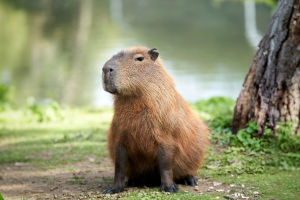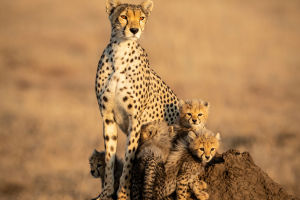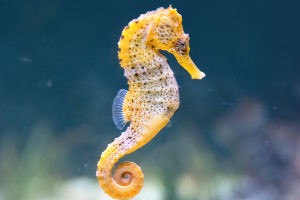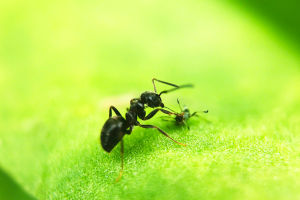
Have you ever wondered why so many animals seem to gravitate toward the capybara?
Whether they are lounging in the water, munching on grass, or just wandering around, animals of all kinds – not just predators – love sitting on, resting next to, or simply hanging out around the world's largest rodent.
Yes, you guessed it – we're talking about the capybara, a remarkable creature that weighs up to 66 kilograms (145 pounds).
In this article, we'll dive into the unique characteristics of the capybara, why so many animals seem drawn to it, and what makes this gentle giant such a fascinating member of the animal kingdom.
What Is a Capybara?
The capybara, a member of the Caviidae family, is a giant among rodents. It is often compared to the size of wild boars due to its large frame and its affinity for water. The capybara's scientific name, Hydrochoerus hydrochaeris, reflects its aquatic lifestyle – "hydro" meaning water and "choerus" meaning choerus, linking it to its swimming ability and its pig-like appearance. The name "capybara" comes from the Tupi language of South America, where "ka`apiuara" means "grass-eater," a nod to its plant-based diet.
Capybaras are found in South America, primarily in regions near water, such as rivers, lakes, and wetlands. They are known for their distinctive features: large heads, heavy snouts, short legs, and rough fur, which can come in shades of reddish-brown, yellow-brown, or dark brown.
Life of a Capybara
Capybaras are social animals that live in groups, often led by a dominant male. These groups usually consist of several females and their young. One of the most fascinating things about capybaras is their social behavior; they spend a lot of time grooming one another, helping to control parasites such as fleas and ticks. Their daily routine revolves around water, where they enjoy spending their mornings. During the hottest part of the day, they rest, and they become more active in the evening and at night when they forage for food.
How Do Capybaras Digest Food?
Capybaras, like other rodents such as rabbits, engage in a behavior called "coprophagy," meaning they eat their fecal pellets to aid in digestion. These special pellets, which come from their cecum, help to break down the tough plant fibers they eat. The cecum, a large fermentation chamber, is filled with bacteria and enzymes that assist in breaking down plant material, making it easier for the capybara to digest.
Capybaras consume around 3 kilograms (6.5 pounds) of fresh grass daily, and they particularly enjoy reeds, aquatic plants like water hyacinths, and even crops such as rice and sugarcane. This plant-based diet is crucial to their health and energy.
Water-Loving Creatures
Capybaras are natural swimmers, thanks to their partially webbed feet. Their semi-webbed feet are perfect for life in wetland areas, where they can easily navigate through the water. These creatures can stay submerged for up to 5 minutes at a time. When they sense danger, they dive into the water and only their nostrils and eyes peek out from the surface. They communicate with one another through a variety of vocalizations, including growls, whistles, and hisses.
Reproduction and Lifespan
Capybaras typically breed in the water, and each year they give birth to a litter of 4-5 pups. These pups are born with their eyes open and are able to eat grass within a few days. They nurse for about 16 weeks, making them highly independent from an early age. In the wild, capybaras live for around 7-10 years, but in captivity, they can live up to 15 years.
Capybaras as the “Animal Couch”
One of the most unique things about capybaras is their reputation as the "natural couch" or "pillow" for other animals. Many animals, including birds, monkeys, and even cats, love sitting on or hanging out near capybaras. While capybaras are grazing or resting, smaller animals often treat their backs as resting spots or grooming stations. Birds, for example, often perch on the capybara's head, feasting on the parasites that live on its fur, like fleas and lice.
There are even reports of capybaras lying on their sides, offering their bellies to birds in need of cleaning. It's not uncommon to see capybaras calmly allowing these animals to take care of them in this way. Some birds, like the little yellow-headed birds, even clean inside the capybara's nostrils by picking out the ear mites.
Why Are Animals So Drawn to Capybaras?
The mutually beneficial relationships between capybaras and other animals are not unique, but they are certainly captivating. In captivity, it's not just birds that form bonds with capybaras; monkeys, especially spider monkeys, are often seen riding on the capybara's back or grooming it. The peaceful nature of the capybara and its tolerance for other animals make it an ideal companion for other species. Even though capybaras and monkeys don't naturally share the same habitat in the wild, they still form these close bonds in more controlled environments, such as zoos.
It's not just zoos where this happens – you can find videos online of various animals, from ducks to cats, sitting or lounging on capybaras. Their calm and friendly demeanor make them perfect hosts for such interactions.
Conclusion: The Fascinating Life of Capybaras
Capybaras are truly unique creatures, not just because of their size and swimming skills, but also because of the special relationships they form with other animals. Whether they're offering a perch to a bird, providing comfort to a monkey, or simply being their serene selves, capybaras have earned the title of "nature's sofa." So, Lykkers, next time you come across a capybara, remember it's not just an ordinary animal – it's a peaceful giant with a heart as big as its size!


